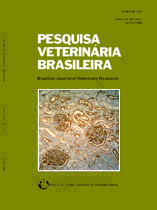 |
|
|
|
Year 2013 - Volume 33, Number 8
|

|
Reproductive performance in bovine receipts non infected and naturally infected with Neospora caninum after embryo transfer, 33(8):970-974
|
ABSTRACT.- Sturaro L.G.R., Zanenga C.A., Pedroso M.F., Palazzi E.G., Queiroz R.K.R. & D´Angelo M. 2013. [Reproductive performance in bovine receipts non infected and naturally infected with Neospora caninum after embryo transfer.] Desempenho reprodutivo entre receptoras bovinas não contaminadas e naturalmente infectadas por Neospora caninum, após a transferência de embriões. Pesquisa Veterinária Brasileira 33(8):970-974. Laboratório de Biologia Celular, Instituto Biológico, Av. Conselheiro Rodrigues Alves 1252, Vila Mariana, São Paulo, SP 04014-002, Brazil. E-mail: luisgustavo_vet@yahoo.com.br
The use of knowledge in biotechnologies for improving the production of goods and services has advanced significantly. The control of infectious diseases continues to represent the most obstacle to the health of animals. The embryonic loss may be responsible for the increase in economic losses for producers isolated from cattle. Infection with Neospora caninum has emerged as an important reproductive disease and, in several countries, has been diagnosed as the main cause of abortion. The aim of this study was to evaluate the reproductive performance in not contaminated and naturally infected with Neospora caninum bovine receipt after embryos transfer (ET). The choice of animals (n=395) for the experiment was performed by gynecological evaluation, via transrectal palpation. Vaccinations recommended for health protocol followed the ET. Nutritional management was based on the National Research Council (NRC, 1999). The ET of thawed embryos was made after the synchronization of the estrous cycle of the receipts. To evaluate the reproductive performance of transrectal ultrasonography was used. The identification of the positive receipts for Neospora caninum was performed by ELISA and reagents for samples, confirmation by indirect immunofluorescence (IIF). Data were analyzed using Past® and were considered statistically significant (P<0.01). The results show a rate of pregnant (n=191) of 48.35%, followed by an abortion rate at 60 days of gestation (n=14) and 3.5% of abortions in the sixth month of gestation (n=12) of 3.04%. These results become relevant when taking into consideration that infected receipts by the protozoan not showed a high rate of pregnancy loss. The statistical insignificance of the data obtained in this study provides the security suggesting that there is no need to deploy the diagnosis or prior control to neosporosis in receipts able to ET. |
| |
|
|
| |
|
 |